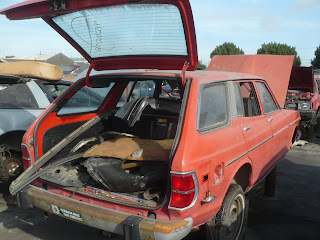
It's not too often we choose to cover Japanese cars here on RWP - but a recent trip to California made me remember just how much the Asian Invasion of the 1970s helped define the current automotive landscape and it made me nostalgic for the era of the rear-wheel-drive economy car.
Datsun's B210 series, launched in the United States in 1973, was a fuel-efficient line of pint-sized coupes, sedans and wagons. The predecessor to today's rather lackluster Sentra, the B210 was an instant success the minute gas prices skyrocketed and it lives on today with a small but loyal following. A BMW 2002 it ain't, but it also cost a fraction of that default German cult car.
Powered by either a 1.3-liter or 1.4-liter four-banger, the B210 was no hot rod. Although not nearly as emissions-strangled as a V8, the four-cylinder was never rated at more than 85 horsepower. A five-speed manual came towards the end of the B210's era, but rather than offering performance benefits, its gear spacing optimized fuel efficiency. Amazingly, the EPA rated the B210 at 50 mpg with the five-speed shifter - a number achieved today (using modern calculations) only in hybrids.
It wasn't a hot handler like the 510, but contemporary media often favorably compared the B210 to the Ford Mustang II.
The B210 is extinct in most parts of North America, but thanks to California's steel body-friendly climate and a population inclined to buy imports (a friend of mine argues that Californians hate Detroit), they're not gone entirely. This one, spotted in an L.A.-area junkyard, will be crushed soon.




1 comment:
My dad had one of these Datsun B210s when he was in college in the late '70s. He bought it as a total loss, very cheaply. He took the engine and gearbox apart, overhauled them, and rebuilt everything, while he was fixing the body. It had been slammed in sideways on one front wheel by another car. He bent the body back straight and then bolted in something similar to those bars they put between the strut tops on rice cars, except made of angle iron, to keep the engine bay from caving back in. When he finally got it back together, it was a great runner!
Served him well through Minnesota winters and a trip or two out east for about six years before he got it sideways on a highway with a little snow on top of glare ice, and had to choose smashing the nose in on the guardrail over sliding under the ass-end of a semi trailer.
Post a Comment